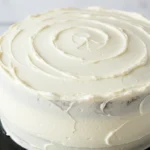How to Make White Velvet Cake (Super Moist & Easy!)
I still remember the first time I baked a White Velvet Cake. I was on a mission to find the perfect vanilla-based cake, something softer than classic vanilla cake, richer than a sponge cake, and with a melt-in-your-mouth texture that made every bite feel like a dream.
Servings: 12 Slices
Calories: 890kcal
Ingredients
Cake Ingredients
- 8 oz unsalted butter 2 sticks
- 14 oz sugar
- 6 large egg whites fresh
- 14 oz flour
- 2 ½ teaspoon baking powder
- ½ teaspoon salt
- 1 teaspoon almond extract use clear for a whiter cake
- 1 ½ teaspoons vanilla extract
- 10 oz milk 295 ml
- 2 oz vegetable oil 60 ml
Frosting Ingredients
- 8 oz pasteurized egg whites room temperature
- 32 oz powdered sugar 4 cups
- 32 oz unsalted butter 4 cups
- ½ teaspoon salt
- 1 tablespoon vanilla extract
Instructions
- Preheat your oven to 335ºF (170ºC) and prepare two 8-inch round cake pans. You can grease the pans with butter and dust them with flour or use cake goop (a blend of flour, oil, and shortening) to ensure the cakes release smoothly once baked.
- In a separate bowl, mix together the milk, vegetable oil, and both vanilla and almond extracts. Set this aside for now so it’s ready when you move to the dry ingredients.
- Sift together the flour, baking powder, and salt in another bowl. This step is key for even distribution of the baking powder and to avoid any lumps.
- In a stand mixer, cream the softened butter on medium speed until smooth. Add the sugar and beat on high for about 5 minutes until the mixture is light, airy, and pale. This step creates the tender crumb we’re aiming for.
- Gradually add the egg whites one at a time, mixing on low speed. Let each egg white fully incorporate before adding the next. Ensure your egg whites have reached room temperature before using.
- Alternate adding the dry ingredients and wet ingredients to the butter mixture. Start with one-third of the dry ingredients, mix on low until just combined, then add half of the milk mixture and mix again. Repeat this process, ending with the remaining dry ingredients. Take care not to overmix the batter, or it may lose its light texture.
- Evenly divide the batter between the prepared pans and gently tap them on the counter to level the batter.
- Place in the preheated oven and bake for 25 to 35 minutes, or until a toothpick poked into the middle comes out without any wet batter.
- Allow the cakes to rest in their pans for 10 minutes, then gently move them to a wire rack to cool fully. This ensures they firm up and makes frosting easier.
- While the cakes cool, make the buttercream. In a stand mixer, combine the egg whites and powdered sugar, mixing on low speed to combine. Increase the speed to high and whisk until frothy.
- Add the butter in small chunks, allowing it to fully incorporate before adding the salt and vanilla extract. Beat the frosting until it becomes light, airy, and smooth.
- Once the cakes are cool, place one layer on a cake stand or serving plate. If you prefer, trim off any thin, browned layers from the top and bottom for a smoother finish.
- Apply a thick layer of frosting on top, then smooth it evenly. Add the second layer of cake and press gently to secure.
- Cover the top and sides with frosting, smoothing it for a clean, polished look.
- For a decorative touch, use a cake spatula to create soft swirls or keep it sleek and simple. Enjoy your beautifully frosted cake!
Notes
- Sifting your dry ingredients isn’t optional, it’s the secret to a light, airy cake!
- When adding the wet and dry ingredients, do it gently, and don’t overmix, a light hand ensures a fluffy texture.
- I like to trim both the top and bottom of my cakes if they rise unevenly, it helps create a smooth, even surface for frosting.
- Make sure the cakes are fully cooled before frosting them; it makes the whole process so much easier!
